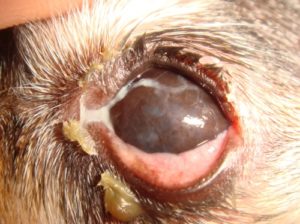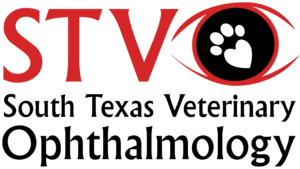ARTICLES
PREVENTATIVE EYE CARE FOR PETS
Published Tuesday, June 9, 2015

What can you do keep your pet’s eyes healthy?
First of all, you will want to get used to looking at your pet’s eyes very closely. Once you know what is normal. it will be much easier to know when something is abnormal. It is best to perform a weekly eye exam so that you catch any problems very quickly. Eye irritation or infection can be painful to your pet and at times can lead to vision loss.
What are you looking for on these weekly exams?
Your pet’s eyes should be open and the whites of the eyes should not be red or bloodshot. A healthy eye is clear and the surface (the cornea) is smooth and shiny (moist). Signs of eye trouble include squinting (holding the eye shut), redness at the top of the eye (under the upper eyelid), discharge that is green or yellow, crusted discharge on the eyelids, cloudiness in the eye, excessive tearing, or vision loss. If you have a light (even a cell phone light will work), it will make the eye exam easier. The light will also allow you to look at the pupil which is the circle inside the eye. The pupils are usually equal in size and will get small with bright light. Don’t hold the bright light in your pet’s eyes too long – this is just a quick check.
Proper preventative eye care:
- Weekly eye exams
- Weekly or daily cleaning: Some pets may require more frequent cleaning to keep their eyes healthy and comfortable. With a warm cloth or gauze square, remove any debris at the corner of the eyes or on the fur around the eyes. If the discharge is tenacious, there are over the counter products to loosen the debris and make it easier to remove. One product is called Ocu-soft and is available over the counter at human pharmacies. Your veterinary ophthalmologist will also have cleaning products available.
- Keeping eyes clear of mucus. Just like humans, pets can have “sleep” in the morning and have mucus discharge after being exposed to wind, dirt and pollen. Your pet will be more comfortable if the mucus is removed. If the discharge is in the eye, you can use eye wash or artificial tears to remove it. Eye wash is available over the counter at human pharmacies. Be sure not to use contact lens cleaning solution! Artificial tears come in a number of brands and formulas. Genteal Gel, Refresh tears, and Tears Naturale are all good choices. You can flush the eye with the eye wash and then wipe the eye with a soft cloth. If you are using artificial tears, apply 3 – 4 drops in each eye and allow your pet to blink. This will drive the mucus to the corner of the eye where you can safely wipe it away.
- Keeping hair trimmed away from the eyes. There are 3 main reasons for keeping the hair trimmed. Number 1: When the hair is trimmed you can see the eyes better and will notice problems faster. Number 2: Short hair will not accumulate as much debris and therefore you will not have to clean the eyes as much. Number 3: Hair rubbing or touching the eye will lead to more discharge (tear staining) and can scratch the eye. This is particularly important in breeds that have short noses and skin folds near the eye (Lhasa Apso, Shih Tzu, Pekingese, Persian, Himalayan, etc). It is always important to use blunt-nosed scissors when working around the eye. If you are not comfortable trimming the hair, take your pet to your veterinarian or groomer.
- Apply an eye lubricant ointment before bathing or taking your pet to the groomer. Lubricant ointments are available over the counter in the artificial tear aisle of the pharmacy. The main ingredients are white petrolatum and light mineral oil. Puralube, Refresh PM, Tears Naturale PM are all good choices. These products will be applied as a salve rather than a drop. They will create a barrier across the cornea to protect the eye from shampoo and other grooming chemicals.
Groomers
Many pets require regular trips to the groomers. Our recommendation is that you apply one of the eye lubricant ointments before each grooming session. Also, request that your pet be hand dried rather than being placed in a drying cage with a fan blowing (this can dry their eyes). When you pick up your pet, instill several drops of artificial tear solution as soon as you get home. This will help rinse away any extra hairs or chemicals that might still be in the eyes.
Protecting pet’s eyes
A company called Doggles makes goggles and glasses for dogs. They come in many sizes and color combinations. Not all pets will tolerate wearing Doggles. Pets that are very active, outdoors for long periods of time, or that like to hang their head out the car window could benefit from a set of Doggles.
What do you do if you notice a change?
If you notice loss of sight, eye discoloration, behavioral changes, clouding of the eye or cataracts, red or swollen eyes, a growth on or near eye, light sensitivity/squinting, excessive tearing or abnormal ocular discharge, or rubbing/pawing at eyes, the first step is to contact your pet’s regular veterinarian. They will be able to exam the eyes and perform basic diagnostic tests.
Your pet should see a board-certified ophthalmologist when their eyes are not improving with standard therapy or the diagnosis includes emergencies such as corneal or lens lacerations, intraocular bleeding, uveitis, deep corneal ulceration, glaucoma, sudden blindness, or cataracts. We encourage veterinarians to contact STVO when their client issues are beyond the scope of typical therapy. At all times, we work in conjunction with your regular veterinarian to ensure your pet receives the best possible care.
 Located in the SAVS Facility
Located in the SAVS Facility
